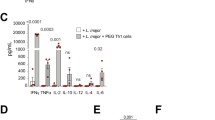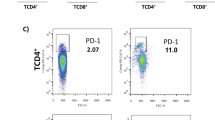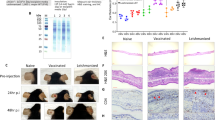Abstract
Most clinical cases of cutaneous leishmaniasis caused by Leishmania tropica major consist of self-healing lesions that are associated with the development of strong specific cell-mediated immunity (CMI) detected by delayed-type hypersensitivity (DTH)1,2. At the other extreme are susceptible individuals who develop persistent or diffuse forms of the disease. This spectrum of cutaneous leishmaniasis can be reproduced in in-bred mouse strains according to their genetic constitution3. BALB/c mice are exceptionally susceptible: the disease can be induced with minimum infecting doses and is inexorably progressive, terminating in cutaneous and fatal visceral metastasis3–7. In this case, potentially curative CMI is abrogated by the generation of a specific Lyt-1+2−, I-J− population of suppressor T (Ts) cells8,9, whose induction is probably secondary to a primary macrophage defect10,11 controlled by a single major non-H–2-linked autosomal gene5,6. The generation of the Ts cells can be prevented and infection cured by prior sublethal (550 rad) irradiation8. The potency of the Ts cells is such that as few as 106 cells transferred adoptively can completely reverse this prophylactic effect9. In view of their potency and potential relevance to clinical leishmaniasis, I have now studied Ts cells at the clonal level to delineate further their functional characteristics and interaction with the effector mechanism. I report here a cloned T-cell line expressing specific suppression against in vitro lymphocyte proliferation and in vivo induction of DTH to L. tropica antigens.
This is a preview of subscription content, access via your institution
Access options
Subscribe to this journal
Receive 51 print issues and online access
$199.00 per year
only $3.90 per issue
Buy this article
- Purchase on Springer Link
- Instant access to full article PDF
Prices may be subject to local taxes which are calculated during checkout
Similar content being viewed by others
References
Garnham, P. C. C. & Humphrey, J. H. Curr. Topics Microbiol. Immun. 48, 29–42 (1969).
Turk, J. L. & Bryceson, A. D. M. Adv. Immun. 13, 209–266 (1971).
Kellina, O. I. Medskaya Parazit. 42, 279–285 (1973).
Handman, E., Ceredig, R. & Mitchell, G. F. Aust. J. exp. Biol. med. Sci. 57, 9–29 (1979).
Howard, J. G., Hale, C. & Chan-Liew, W. L. Parasite Immun. 2, 303–314 (1980).
DeTolla, L. J., Scott, P. A. & Farrell, J. P. Immunogenetics 14, 29–39 (1981).
Nasseri, M. & Modabber, F. Z. Infect. Immun. 26, 611–614 (1979).
Howard, J. G., Hale, C. & Liew, F. Y. J. exp. Med. 153, 557–568 (1981).
Liew, F. Y., Hale, C. & Howard, J. G. J. Immun. 128, 1917–1922 (1982).
Howard, J. G., Hale, C. & Liew, F. Y. Nature 288, 161–162 (1980).
Gorcynski, R. M. & MacRae, S. Cell. Immun. 67, 74–89 (1982).
Carroll, A. M., Palladino, M. A., Oettgen, H. & DeSousa, M. Cell. Immun. 76, 69–80 (1983).
Dvorak, A. M. et al. J. exp. Med. 157, 843–861 (1983).
Smith, K. A. & Ruscetti, F. W. Adv. Immun. 31, 137–173 (1981).
Moller, G. (ed.) Immun. Rev. 63, (1982).
Fresno, M., Nabel, G., McVay-Boudreau, L., Furthmayer, H. & Cantor, H. J. exp. Med. 153, 1246–1259 (1981).
Heuer, J., Bruner, K., Opalka, B. & Kolsch, E. Nature 296, 456–459 (1982).
Lamb, J. R. & Feldmann, M. Nature 300, 456–458 (1982).
Louis, J. A. et al. Immun. Rev. 61, 215–243 (1982).
Kaufmann, S. H. E. & Hahn, H. J. exp. Med. 155, 1754–1765 (1982).
Author information
Authors and Affiliations
Rights and permissions
About this article
Cite this article
Liew, F. Specific suppression of responses to Leishmania tropica by a cloned T-cell line. Nature 305, 630–632 (1983). https://doi.org/10.1038/305630a0
Received:
Accepted:
Issue Date:
DOI: https://doi.org/10.1038/305630a0
This article is cited by
-
Tolerance Induction and Maintenance in Primed Lymphocytes
Survey of Immunologic Research (1985)
Comments
By submitting a comment you agree to abide by our Terms and Community Guidelines. If you find something abusive or that does not comply with our terms or guidelines please flag it as inappropriate.



